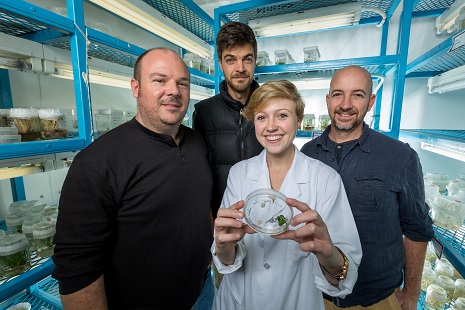A major effort is underway to conserve the last remaining 60 individual paintbrush lilies (Haemanthus pumilio) in the Duthie Nature Reserve in Stellenbosch, as well as increase the population through micropropagation.
Martin Smit, curator of the Stellenbosch University Botanical Garden, says more than a thousand of the paintbrush lilies once grew in the Duthie reserve. But the reserve is now less than a third of its original size, and the lilies have all but disappeared from previously known locations including Wellington and Klapmuts.
“The main reasons for its decline are the destruction of its original habitat (rhenosterveld) and invasives like Port Jackson (Acacia saligna). But the species is also dependent on fire to induce flowering and requires very specific conditions for the seedlings to survive. For various reasons the Duthie Reserve was last burned in 2004. For this type of vegetation, it is long overdue for another controlled burn," he says.
“Apart from being fire-dependent, Haemanthus pumilio also prefer ground that is dry in summer but waterlogged and marshy in winter. That is why the Duthie Reserve still remains the most suitable habitat to ensure the survival of this rare and critically endangered plant," he adds.
While Smit has developed a management plant for the Duthie Reserve, two biologists from Stellenbosch University have obtained funding to employ tissue culture as a means of exponentially increasing the population.
Plant biotechnologist Dr Paul Hills and botanist Dr Gary Stafford have already collected leaf samples and seed from the existing paintbrush lily population in the Duthie Reserve, as well as from seven individuals from a now extinct population from Newton Commanage, Wellington, currently under the care of the Botanical Garden.
“Firstly, we are following a non-destructive strategy to mass propagate individuals from a variety of genotypes to allow for potential repopulation of dwindling populations in the Duthie Reserve and elsewhere," Dr Hills explains.
At the same time, BSc Honours student Dominique West will use phylogenetic analysis to determine the genetic diversity within and between populations. This will allow for informed decisions to be made with regard to the use of genetic lines derived from micropropagation when it comes to repopulating and conserving the plants.
While the tissue culture samples and several seeds have already started growing in the tissue culture lab, the first seedlings will only be viable by the end of 2018.
“Because it so rare, Haemanthus pumileo is highly sought after by plant collectors locally and internationally. If we can get a viable population going, these will be spread to other botanical gardens and then some plants might be sold," Smit adds.

The Stellenbosch University Botanical Garden is driving a major effort to conserve the last remaining paintbrush lilies (Haemanthus pumilio) in the Duthie Nature Reserve. Curator Martin Smit (middle) is also working with Stellenbosch University biologists Dr Paul Hills (left) and Dr Gary Stafford (right) to increase the population through tissue culture cultivation techniques. BScHons student Dominique West will conduct the micropropagation and systematic analysis. Photo: Stefan Els
On the photo at the top: Only 10-15 centimetres high, Haemanthus pumilio is one of the smallest paintbrush lilies. The plants usually flower during March and April, before the leaves develop. This species prefers to flower after fire, when there is less competition from other vegetation. Photo: Gary Stafford
More about Haemanthus
All 22 species of Haemanthus are endemic to South and Southern Africa, but of these at least 12 are listed in the South African Red Data List. However, Haemanthus pumilio's status urgently needs revision as it is under the greatest risk of extinction. Since the 1990s, the Duthie Reserve is home to the only remaining viable population.
More about the Duthie Reserve
The Duthie Reserve in Banhoekweg, Stellenbosch, is named after Dr Augusta Vera Duthie, founder of the Department of Botany at SU in 1902. In 1912 she obtained a PhD from the University of South Africa for her thesis entitled The vegetation and flora of the Stellenbosch flats. She is regarded as the founder of the SU Botanical Garden and grew plants for student practicals and research in glasshouses at the former location of the SU Botanical Garden next to the Old Hoofgebou.
Contact details
Mr Martin Smit
Curator: SU Botanical Garden
E-mail: mfsmit@sun.ac.za
Tel: +27 _21 808 9209
Dr Paul Hills
Institute for Plant Biotechnology, Department of Genetics, Stellenbosch University
E-mail: phills@sun.ac.za
Tel: +27 _21 808 3066
Dr Gary Stafford
Department of Botany and Zoology, Stellenbosch University
E-mail: gistafford@sun.ac.za
Tel: +27 _76 896 1987
Issued by Wiida Fourie-Basson, Media: Faculty of Science, Stellenbosch University
science@sun.ac.za 021 808 2684

